
| What is Flavor and Fortune? |
| How do I subscribe? |
| How do I get past issues? |
| How do I advertise? |
| How do I contact the editor? |
Read 12861765 times
Connect me to:
| Home |
| Articles |
| Book reviews |
| Letters to the Editor |
| Newmans News and Notes |
| Recipes |
| Restaurant reviews |
| Article Index (all years, slow) |
| List of Article Years |
| Article Index (2025) |
| Article Index (last 2 years) |
| Things others say |
| Related Links |
| Log In... |
| Authors |
| Categories & Topics |
Foods of Beijing: China's Royal Food
| by Habeeb Salloum |
Chinese Food in China, Hong Kong, and/or Taiwan
Fall Volume: 2012 Issue: 19(3) page(s): 9 -12

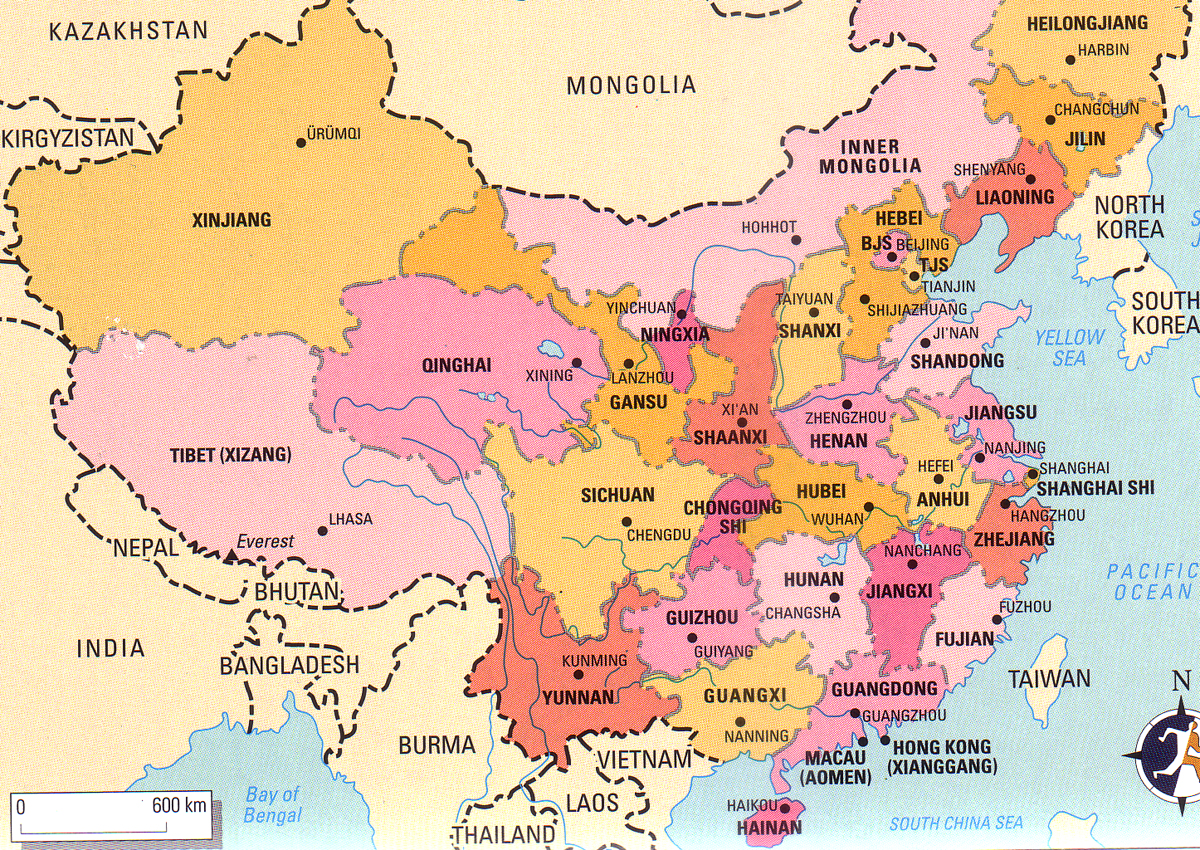 Rarely does anyone question that Beijing, which translates to 'northern capital' has developed as one of the most important cuisines in the world. History agrees, for hundreds of years this city was the royal capital of China, and for these many centuries, its inhabitants considered it and its food at the center of the world. With such high regard, it is any wonder the Chinese developed a world-renowned cuisine epitomized by the Beijing kitchen?
Rarely does anyone question that Beijing, which translates to 'northern capital' has developed as one of the most important cuisines in the world. History agrees, for hundreds of years this city was the royal capital of China, and for these many centuries, its inhabitants considered it and its food at the center of the world. With such high regard, it is any wonder the Chinese developed a world-renowned cuisine epitomized by the Beijing kitchen?
For some five hundred years, dynasty after dynasty made Beijing their capital, each enriching it with new culinary attributes. The Liao, Jin, Yuan, Ming and Qing Dynasties, once they took power, brought with them culinary traditions from whence they came. Along with nomadic tribes who, at times, took over the city and added their bit to Beijing cookery, a cuisine was born that became known as The Royal Kitchen of China.
The emperors built a royal city within the larger city that became known as the Forbidden City; and from here, they ruled their empire. Some twenty thousand of the best chefs in China worked in the kitchens of this royal city feeding its emperors and their entourages.
They had at their command the best food in the country and the means to acquire whatever they needed. Hence, were able to create some of the most refined and delectable dishes in the world. From their famous grand and elaborate banquets, it was not uncommon to find, besides main dishes, two hundred cold dishes and dozens of drinks and pastries. It was here that much of Beijing's rich culinary tradition was born.
Known as the Shandong, Mandarin, and more commonly as Beijing cuisine, this royal kitchen of the past is a major part of Chinese cuisine. This cuisine mainly includes the foods of northern China, particularly those made with meat. Cooks for the Mongolian and other northern emperors created from and considered meat their basic food. It is these dishes that the most famous and renowned dishes for which Beijing is known were developed. They were embellished with local foods, including those of Muslims and others from other regions of the country. These dishes, and the foods needed to make them, were brought to the capital by way of foreign merchants, vassal embassies, literati, and important court officials, among others.
Even when emperors were no longer in power, the Beijing kitchen continued to evolve. Today, the city offers, besides its traditional dishes, a wide range of international ones. Therefore, in this city, one can find foods of virtually the entire world. As Western visitors explore the streets of Beijing, they can find all types of European restaurant foods including French, Italian, and Russian, along with other Asian foods including those of India and Korea, even the fast foods of North America like Kentucky Fried Chicken, McDonald's, Pizza Hut, and other outposts of the world's fast-food cuisines. All of these modern foreign introductions do not compare with the food of the emperors and dishes made to satisfy them and their royal families.
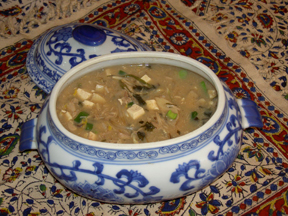
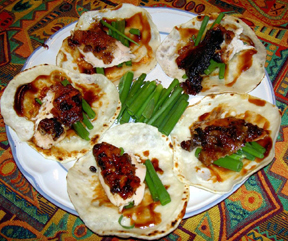
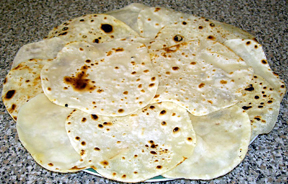 Traditional Beijing dishes such as Beijing Duck and Hotpot remain popular on the menus of local inhabitants. Mutton plays a major role in the Beijing kitchen because Mongolian emperors and the privileged class of the Yuan Dynasty were enamored with this meat. In fact, it is estimated that eighty percent of their dishes are based on the meat of this animal, young and old. These foods include many lamb dishes and instant boiled mutton, quick fried mutton tripe, stewed mutton, and other popular lamb dishes. They are still on the daily menu of the people of Beijing and its surrounding regions.
Rice, which most people think is the base of Chinese food, is not very important in Beijing's cuisine. Wheat products are of prime importance in this capital royal cuisine including breads, baked, fried or steamed, and dumplings, noodles and pancakes. Restaurant owners use them to enhance their establishments and their offerings. Visitors are usually totally enchanted in noodle restaurants, and like to see demonstrators transforming a handful of dough pulling it into long even-size noodles.
Traditional Beijing dishes such as Beijing Duck and Hotpot remain popular on the menus of local inhabitants. Mutton plays a major role in the Beijing kitchen because Mongolian emperors and the privileged class of the Yuan Dynasty were enamored with this meat. In fact, it is estimated that eighty percent of their dishes are based on the meat of this animal, young and old. These foods include many lamb dishes and instant boiled mutton, quick fried mutton tripe, stewed mutton, and other popular lamb dishes. They are still on the daily menu of the people of Beijing and its surrounding regions.
Rice, which most people think is the base of Chinese food, is not very important in Beijing's cuisine. Wheat products are of prime importance in this capital royal cuisine including breads, baked, fried or steamed, and dumplings, noodles and pancakes. Restaurant owners use them to enhance their establishments and their offerings. Visitors are usually totally enchanted in noodle restaurants, and like to see demonstrators transforming a handful of dough pulling it into long even-size noodles.
Northern China is a region of extremes. The summers are hot and dry, the winters bitterly cold with chilling Arctic winds blowing in from Mongolia and Manchuria. Because of the harsh climate, Beijing dishes tend to be substantial.
Liberal use of hardy vegetables that grow well in cold climates are the main garden produce in the Beijing kitchen. Cabbages and root vegetables such as potatoes and turnips are flavored with bean paste, coriander, leeks, garlic, ginger, peppers, and soy sauce. These are the flavorings used most often when preparing meals in Beijing.
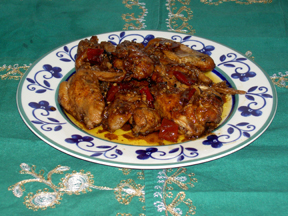 Braising, deep-frying, instant boiling, roasting, stewing, and stir-frying are all used in the preparation of foods in Beijing and throughout northern China. The techniques used in local cookery methods, plus flavorings utilized with them that have been popular over the centuries, have evolved to produce many local culinary delights. The method of cooking and condiments used produced thousands of dishes with special flavors. They are literally unmatched by most other cuisines. It is said that the Beijing kitchen defuses delicious uniqueness into the art of Chinese cuisine.
Braising, deep-frying, instant boiling, roasting, stewing, and stir-frying are all used in the preparation of foods in Beijing and throughout northern China. The techniques used in local cookery methods, plus flavorings utilized with them that have been popular over the centuries, have evolved to produce many local culinary delights. The method of cooking and condiments used produced thousands of dishes with special flavors. They are literally unmatched by most other cuisines. It is said that the Beijing kitchen defuses delicious uniqueness into the art of Chinese cuisine.
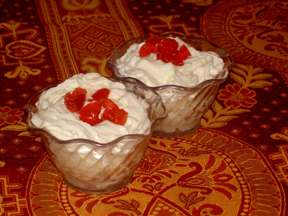 The restaurants of Beijing offer visitors and locals a gourmet paradise. They provide the city's traditional dishes and they embellish those from other regions in China and other countries worldwide. The city's food even beats the Great Wall in drawing travelers. People visit to experience the cuisine of the Imperial Kitchen and enjoy its many refined culinary tastes, even its Peking Dust.
The restaurants of Beijing offer visitors and locals a gourmet paradise. They provide the city's traditional dishes and they embellish those from other regions in China and other countries worldwide. The city's food even beats the Great Wall in drawing travelers. People visit to experience the cuisine of the Imperial Kitchen and enjoy its many refined culinary tastes, even its Peking Dust.
From this famous cuisine, are a few traditional imperial dishes simplified below for layman and other non-culinary folk who know not the ways of a restaurant kitchen. Even in their simplified forms, they ooze royal ancestry to be enjoyed. Feel royal while doing so.
The first recipe is for Beijing Duck, often called the epitome of Chinese cuisine. Traditionally served in three courses, a soup made from the duck bones is its first course. Next comes duck pieces accompanied by cuts of crisp skin, both wrapped in Chinese pancakes with sliced scallions and hoisin sauce. In restaurants, this is usually the only course served. The third traditional course is stir-fried duck meat. These three dishes from a Beijing Duck are prized, above all, for the bird's crisp skin.
Enjoy this classic dish and others found below and elsewhere.
_____
Habeeb Salloum is a Canadian-based full-time freelance writer and author specializing in food, history, and travel. Besides seven books and nineteen chapters in other volumes, he has written hundreds of articles about culture, food, travel, history, and homesteading in western Canada. They appear in such publications as The Toronto Star, Globe and Mail, Western Producer, Vegetarian Journal, Saveur, and many other magazines and newspapers. The pictures with this article are his, and we thank him for them.
| Beijing Duck is China's Royal Food |
|---|
1 whole 4 to 5 pound duck, innards removed and discarded 1 Tablespoon cinnamon 1 Tablespoon ground ginger 1 and 1/2 teaspoons pepper 1 teaspoon ground aniseed 1/2 cup honey 2 Tablespoons sesame oil 2 Tablespoons vinegar 1 small bunch scallions, cut in half lengthwise, then cut into two-inch pieces hoisin sauce Peking Duck pancakes, their recipe follows Preparation: 1. Fill a pot large enough to hold the duck three-quarters full of water and bring it to boil. Remove the pot from heat and put duck in the boiling water for about eight minutes. Then, remove duck, pat it dry, and allow to rest for about an hour. 2. Place remaining ingredients, except the scallions and the hoisin sauce, in a saucepan and bring to boil. Then remove it from heat and allow to cool. 3. Baste the duck all over, both inside and out, with the spice mixture and let it stay covered and in the refrigerator for four hours or until the skin of the duck dried thoroughly. 4. In an oven preheated to 350 degrees F, put the duck breast side up, for thirty minutes then turn it over and roast for another thirty minutes. Turn it over again and roast for fifteen minutes then turn it one more time and roast for another fifteen minutes. It may need to be turned another time or two during yet another thirty minutes of further cooking until the skin browns evenly. 5. Then cut and serve the duck meat as pieces and accompany them by pieces of crisp skin wrapped in Chinese pancakes with the scallions and the hoisin sauce. |
| Chinese Pancakes |
|---|
2 cups flour 2 Tablespoons sesame oil Preparation: 1. Knead the flour with three-quarters of a cup of water to make a dough. Allow this to stand for an hour. 2. Make the dough into eighteen pieces and roll each on into a ball, then roll this into a circle. 3. Brush the top of all circles with sesame oil. Place one circle over a second circle, their oiled surfaces facing each other. Now re-roll each pair of circles into one five-inch circle. 4. Heat pan, brush with the sesame oil on top and bottom of the pair of circles and fry them over medium heat for one minute on each side. Then remove and separate them while hot, and then place them on a platter. Cover them and keep them warm until needed. |
| Hot and Sour Soup, Beijing Style |
|---|
1 cup finely chopped cooked chicken 1 cup sliced small mushrooms 1 cup bean sprouts 4 Tablespoons soy sauce 5 cups chicken broth 2 cups chopped tofu 3/4 teaspoon chilli flakes 2 Tablespoons vinegar 2 Tablespoons cornstarch mixed with four tablespoons of cold water 1 egg, beaten 2 Tablespoons sesame oil 2 Tablespoons chopped coriander 4 Tablespoons finely chopped green onions Preparation: 1. Place chicken, mushrooms, bean sprouts, soy sauce and chicken broth in a saucepan then bring to boil. Cover and cook over medium/low heat for five minutes. 2. Stir in remaining ingredients, except coriander and green onions and bring to boil then cook over medium/low heat for about three minutes or until the soup begins to thicken. 3. Place in a serving bowl then garnish with coriander and green onions and serve. |
| Mongolian Hotpot |
|---|
1 pound boneless leg of lamb, cut into paper-thin three- by one-inch slices 4 Tablespoons sesame oil 1 piece fresh ginger, cut into one-inch long by half-inch wide thin slices 4 scallions cut into one-inch pieces 8 small dishes with: soy sauce preserved garlic finely chopped fresh coriander fermented bean curd chilli flakes sesame paste preserved chive flowers, cut into small pieces vinegar Preparation: 1. Spread meat on individual plates. 2. Set out the side dishes in small bowls. 3. Half-fill with boiling water, a two-quart saucepan set on a hot plate on the diners’ table. 4. Add sesame oil, ginger, green onions and three tablespoons of the soy sauce and bring to boil. 5. Each diner sitting around the table should prepare their own sauces in small bowls from the small bowl side dishes. 6. Each person should pick up one lamb slice and cook it in the boiling water for less than a minute or until the meat turns pinkish-white. This cooked slice is then dipped into their own sauce or sauce mixture and eaten. Each person repeats this process eating as much lamb as they desire. |
| Beijing Five-spice Chicken |
|---|
4 Tablespoons Chinese commercial stir-fry sauce 4 cloves garlic, crushed 1/2 teaspoon salt 1/4 teaspoon cinnamon 1/4 teaspoon ground cloves 1/4 teaspoon ground fennel seed 1/4 teaspoon ground aniseed 1/4 teaspoon chilli flakes 3 Tablespoons sesame oil 2 pounds chicken wings or legs Preparation: 1. Combine sauce, garlic, salt the five spices and oil then coat chicken wings or legs and marinate for four hours. 2. Preheat the oven to 350 degrees F, then place chicken wings or legs with their juice side by side in a greased casserole. Cover it and bake for forty minutes, then uncover and turn the chicken over and bake an additional thirty minutes. 3. Serve with cooked rice and drippings in the casserole. Note: The five-spices included in this recipe can be found as a mixture in Asian food and specialty food stores. One to two teaspoons of it is best in this recipe. |
| Zha Jiang Mian are Beijing Noodles with Meat Sauce |
|---|
1 pound Udon or similar noodles 4 Tablespoons sesame oil 4 cloves garlic, crushed 1 pound ground beef 1 Tablespoon grated fresh ginger 2 Tablespoons soy sauce 2 Tablespoons black bean sauce 1 Tablespoon hot bean sauce 1/2 teaspoon salt 1/2 teaspoon pepper 1 cup chicken broth 1/2 cup chopped scallions 1 teaspoon cornstarch mixed with two tablespoons of cold water chopped fresh coriander Preparation: 1. Cook noodles according to directions on package then place on a platter but keep warm. 2. Heat oil in a wok or frying pan, add garlic, meat and the ginger, and stir-fry over medium heat until the meat browns, about twelve minutes. 3. Stir in remaining ingredients, except the coriander leaves, and bring to boil, then reduce the heat and simmer until the sauce thickens, stirring a few times. 4. Spread evenly over the noodles. Decorate with the coriander leaves, and serve. |
| Beijing Style Baked Eggs |
|---|
1 Tablespoon vegetable oil 6 eggs, beaten 1 cup chopped cooked shrimps 1/2 cup fish stock 2 Tablespoons sesame oil 3/4 teaspoon salt 1/2 teaspoon pepper l Tablespoon lemon juice Preparation: 1. Brush oil in the bottom and on the sides of a casserole; and preheat the oven to 350 degrees F.Br> 2. Thoroughly combine all ingredients then put them in the casserole and bake uncovered in the preheated oven for thirty minutes. 3. Serve hot from casserole. |
| Mongolian Lamb |
|---|
2 pounds lamb, thinly sliced then cut into one- by two-inch pieces 4 Tablespoons soy sauce 4 Tablespoons dry wine 4 Tablespoons sesame oil 1 teaspoon sugar 1 teaspoon pepper 1 teaspoon ginger 1 Tablespoon vinegar 4 cloves garlic, peeled and sliced 1 cup chopped scallions Preparation: 1. Thoroughly mix meat with one tablespoon of the soy sauce and one tablespoon of the wine and allow to-marinate for two hours in the refrigerator, turning over every half hour or so. 2. Make a sauce by combining the remaining soy sauce and wine, two tablespoons of the sesame oil, the sugar, pepper, ginger and vinegar, and set this aside. 3. Heat remaining oil over high heat then add garlic and stir-fry for about half a minute, then add meat with its juices and stir-fry for two minutes. 4. Add sauce and bring to boil then stir in the scallions. Stir-fry for another three minutes or until sauce is mostly absorbed. 5. Serve hot. |
| Zhajiang Noodles |
|---|
4 Tablespoons sesame oil 4 cloves garlic, crushed 1/2 pound ground pork 3 Tablespoons soy sauce 2 Tablespoons hoisin sauce 1/2 teaspoon chilli flakes 1/2 teaspoon salt 1/2 pound firm tofu, cut intl half-inch cubes 1 cup finely chopped scallions 1 cup finely chopped peeled cucumber 1 pound wheat noodles, cooked according to package instructions, then placed on a pre-heated platter Preparation: 1. Heat wok or fry-pan, add oil and garlic and stir-fry using medium/high heat for half a minute. 2. Add pork and stir-fry for five minutes then add soy sauce, hoisin sauce, chili pepper flakes, and the salt and stir-fry for two minutes. 3. Stir in tofu and one-third cup of water, reduce the heat to low and cover the pan and simmer for five minutes. 4. Stir in onions and cucumber stir-fry for half a minute; mix well, then pour over warm noodles and serve. |
| Beijing Dust |
|---|
1 pound fresh chestnuts, scored and put into a pot with enough water to cover them 6 Tablespoons sugar 1 teaspoon vanilla extract 2 cups heavy cream, whipped with two tablespoons confectioners sugar, reserving about one-quarter of this for decor 4 Tablespoons chopped candied maraschino cherries Preparation: 1. Bring chestnuts to a boil and cook over medium heat for fifty minutes then drain them and allow to cool somewhat then remove their shells and paper skins. 2. Put the chestnuts, sugar, and the vanilla extract in a food processor and process for half a minute; but do not purée them. 3. Divide the chestnuts into eight dessert dishes and spoon some whipped heavy cream over them. 4. Decorate the chestnuts with a whole or two halves of the cherries and serve. |

Copyright © 1994-2025 by ISACC, all rights reserved
Address
3 Jefferson Ferry Drive
S. Setauket NY 11720